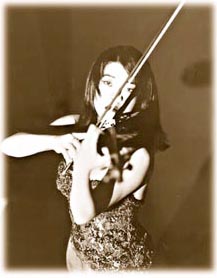![[Metroactive Music]](/music/gifs/music468.gif)
[ Music Index | San Jose | Metroactive Central | Archives ]
Ravel Revealed
The San Jose Symphony shows that the French composer's famous 'Bolero' is tougher than it looks on the page
By Scott MacClelland
EITHER YOU LOVE IT or you hate it. That could explain why Ravel's Bolero is played less often than many of his other works, even ones with more forgettable titles. Another explanation, however, might be the difficulty it poses to an orchestra.
Last Friday's performance by the San Jose Symphony made this clear. For the first time in an all-French program, the last piece of the unusually brief evening, Bolero, disclosed an impossible-to-ignore shortfall of discipline among the winds and brass.
Leading the parade of melodic solos, flutist Maria Tamburrino sounded amazingly self-conscious, with clumsy, stumbling phrases and anxious technique. Her example seemed to spread like a virus, infecting several other wind cameos with awkward, uneasy results.
A one-note horn solo, tongued to imitate the original snare drum pattern, tripped over itself. Not until saxophone master William Trimble showed everyone how it is done--halfway through the piece--did these two sections finally get it together. (And Trimble didn't even get named in the program book!)
But for all the melodic solos and ensembles, the star performer was snare drummer Galen Lemmon, positioned right up front, at the left hand of conductor Leonid Grin. And why not? It is the snare drum that starts the piece pianissimo and repeats itself in ostinato for the duration, changing only by increasing its loudness.
Any eye for detail could not fail to notice that Lemmon's drum carried an unusual amount of metal hardware on its sides. Any inquiring mind would naturally want to know why. The drum, Lemmon explains, was made by Glenn Robinson, retired from the percussion section of the Cincinnati Symphony. "It's called Septimbre, and this is only the 31st he has made. It has three sets of snares, German silver wire, cable and gut. Each has its own sound. The German is very light and sensitive, cable is a thicker-gauge metal and gut produces the heaviest, the 'ballsiest,' sound."
The name Septimbre is explained by the fact that any combination, from none to all three, can be brought into contact with the bottom head of the drum, producing up to seven different timbres. For Bolero, Lemmon engaged the silver and gut snares, and moved the strokes of his sticks from the edge toward the center to follow the swelling crescendo.
And, in case you wondered, Bolero required him to play the original, unchanging pattern 169 times, a fact that surprised even Lemmon, who had never before been asked to tally them. After the performance reached its violent conclusion, conductor Grin dragged Lemmon up on the podium and offered his baton. Like many an athletic achievement, endurance has its rewards.
ATHLETIC WAS NO LESS the way violinist Kyoko Takezawa played through Ravel's hair-raising Tzigane, another technical tour de force, this one set in the smoky night clubs of Budapest. The young virtuoso had earlier displayed a seamless legato and subtle sensuality in Chausson's languid Poeme, but now dug in for a passionate and reckless invasion of Bartok country.
Takezawa's on-the-edge abandon was thrilling, and in her hands, even the Chausson, which can float dreamily like a vapor, enjoyed unusual intensity.
Not all French music is lightly orchestrated for individual effect, or virtuosic by nature: witness Cesar Franck's Le chasseur maudit. The tone poem, which opened the program, engaged five horns, employed an enlarged contrabass section and generally made it heavy going all around.
Fortunately, Franck designed contrasting passages of lighter, ephemeral stuff (recalling the shimmering breezes of his earlier Les eolides). But the accursed huntsman of the title was certainly sent reeling in this case by the sheer weight of thundering symphonic sonority.
[ San Jose | Metroactive Central | Archives ]
![]()
 Athleticism: Guest soloist Kyoko Takezawa works out on 'Tzigane.'
Athleticism: Guest soloist Kyoko Takezawa works out on 'Tzigane.'
From the September 30-October 6, 1999 issue of Metro, Silicon Valley's Weekly Newspaper.